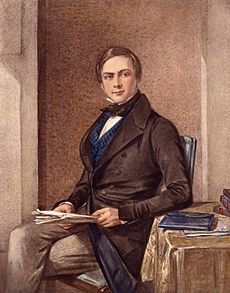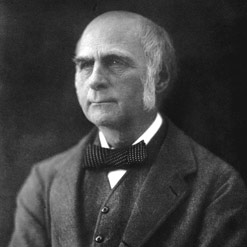Francis Galton facts for kids
Quick facts for kids
Francis Galton
FRS FRAI
|
|
|---|---|
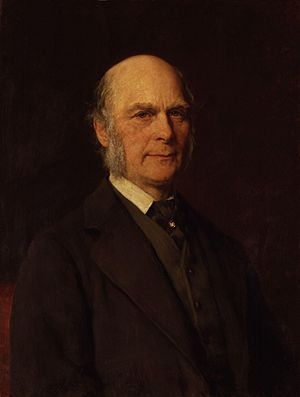
Portrait by Gustav Graef, 1882
|
|
| Born | 16 February 1822 Birmingham, England
|
| Died | 17 January 1911 (aged 88) Haslemere, Surrey, England
|
| Resting place | Claverdon, Warwickshire, England |
| Alma mater | King's College, London Trinity College, Cambridge |
| Known for | Eugenics Behavioural genetics Regression toward the mean Standard deviation Anticyclone Isochrone map Weather map Galton board Galton distribution Galton–Watson process Galton's problem Galton's whistle |
| Awards | Royal Geographical Society's Founder's Medal (1853) Royal Medal (1886) Huxley Memorial Medal (1901) Darwin–Wallace Medal (Silver, 1908) Copley Medal (1910) |
| Scientific career | |
| Fields | Anthropology, Sociology, Psychology, Statistics |
| Institutions | Meteorological Council Royal Geographical Society |
| Academic advisors | William Hopkins |
| Notable students | Karl Pearson |
| Author abbrev. (zoology) | F. Galton, Galton |
Sir Francis Galton (born February 16, 1822 – died January 17, 1911) was a very smart English scientist from the Victorian era. He was interested in many different subjects, like statistics, psychology, and meteorology. He was also a half-cousin of Charles Darwin, the famous scientist who wrote about evolution.
Galton wrote over 340 papers and books. He came up with the idea of correlation, which shows how two things are related. He also helped develop the idea of "regression toward the mean", which means that extreme results tend to be followed by more average ones. He was the first to use statistics to study how people are different and how smartness might be passed down in families. He also started using surveys to collect information about groups of people.
Galton was a pioneer in a field called eugenics, a term he created in 1883. This idea suggested that humans could improve their qualities over generations by carefully choosing who reproduces. He also invented the famous phrase "nature versus nurture", which asks whether our traits come from our genes (nature) or our environment (nurture). His book Hereditary Genius (1869) was one of the first studies to look at what makes someone a genius.
He also helped create psychometrics, which is the science of measuring mental abilities. He developed a way to classify fingerprints, which is still used in forensic science today to solve crimes. Galton even studied the power of prayer and concluded it didn't make people live longer. He was always curious, even about the best way to make tea!
Galton also helped start the scientific study of meteorology (weather). He made the first weather map and came up with a theory about anticyclones (high-pressure weather systems). He also invented the Galton Whistle to test how well people could hear different sounds.
Early Life & Education
Francis Galton was born in Birmingham, England, in a large house called "The Larches." His family, the Galtons, were Quaker gun-makers and bankers, while the Darwins (his mother's side) were involved in medicine and science. Both families had members who loved to invent and were part of the Lunar Society of Birmingham, a group of important thinkers like James Watt and Josiah Wedgwood.
Galton was a very bright child. He could read by age two, knew some Greek and Latin by age five, and was reading Shakespeare for fun by age six! He went to King Edward's School, Birmingham, but he didn't like the strict old-fashioned lessons.
His parents wanted him to become a doctor, so he studied medicine for two years. Later, he studied math at Trinity College, Cambridge. After his father passed away in 1844, Galton became financially independent. He decided to stop his medical studies and instead focused on traveling, sports, and inventing.
Adventures & Discoveries
In his younger years, Galton loved to travel. He went on a solo trip through Eastern Europe to Constantinople (modern-day Istanbul). In 1845 and 1846, he traveled up the Nile River in Egypt and Sudan.
In 1850, he joined the Royal Geographical Society. For the next two years, he went on a challenging trip to South-West Africa (now Namibia). He wrote a book about his experiences called "Narrative of an Explorer in Tropical South Africa." Because of his amazing maps and explorations, he received the Royal Geographical Society's Founder's Medal in 1853. He also wrote a popular book called The Art of Travel, which gave practical advice for travelers in the Victorian era.
Contributions to Science
Galton was a true "Renaissance man" because he made important discoveries in many different areas. He was very good at counting and measuring things, which helped him in his work.
- Weather Maps: He was a pioneer in meteorology. He created the first weather map published in The Times newspaper in 1875. Weather maps are now a common feature in newspapers and on TV worldwide.
- Statistics: He made big steps in statistics, especially with ideas like regression and correlation. These help us understand how different pieces of information relate to each other.
- Psychology: He studied how the human mind works. He was interested in synaesthesia, a condition where people experience one sense through another (like seeing colors when they hear music).
- Biology: He explored how traits are passed down from parents to children.
- Criminology: He helped develop the use of fingerprints for identifying criminals.
Galton was very active in the British Science Association, giving many talks on various topics. He also helped lead the Royal Geographical Society and the Royal Society for many years.
In 1888, Galton set up a special lab at the South Kensington Museum. In this lab, people could pay a small fee to have their physical traits measured. Galton used this information for his own research, gathering lots of data about human differences.
Heredity and Eugenics
When his cousin Charles Darwin published The Origin of Species in 1859, it greatly influenced Galton. He became fascinated by how traits are passed down in animals and humans.
Galton spent much of his life studying human differences, from mental abilities to height and even fingerprint patterns. He had to invent new ways to measure these traits and collect large amounts of data. This led him to discover new statistical methods to understand the information he gathered.
He was very interested in whether human abilities, like intelligence, were hereditary (passed down through families). He studied the family trees of famous people, thinking that if abilities were hereditary, there would be more famous people among their relatives than in the general population. He wrote about this in his book Hereditary Genius (1869).
Galton also studied twins to understand the "nature versus nurture" question. He wanted to see if twins who were similar at birth stayed similar even in different environments, or if twins who were different at birth became more alike in similar environments. He used surveys to collect this data and concluded that "nature" (genes) played a bigger role than "nurture" (environment).
Galton created the term eugenics in 1883. This was a controversial idea that aimed to improve the human race by encouraging people with "good" traits to have more children and discouraging those with "bad" traits from reproducing. He believed that society should encourage marriages between "able" couples by offering them money to have children.
In June 2020, University College London (UCL) decided to rename a lecture hall that was named after Galton because of his connection to eugenics. This shows how controversial and problematic his ideas on eugenics are viewed today.
Statistical Innovations
Measuring Human Traits
Galton was a pioneer in using statistics to understand human differences. He believed that measuring physical traits could help understand how children develop and allow for comparisons between different groups of people.
In 1884, he set up an "Anthropometric Laboratory" at the International Health Exhibition in London. People could pay a small fee to have their height, weight, eyesight, hearing, and other physical characteristics measured. Galton collected data from over 9,000 people. This massive dataset helped him confirm his theories about regression toward the mean in humans.
Understanding Variation
Galton was the first to describe and explain regression toward the mean. This is the idea that if something is very extreme (like a very tall parent), their offspring will likely be closer to the average (not as extremely tall). He first noticed this when studying the size of sweet pea seeds over generations.
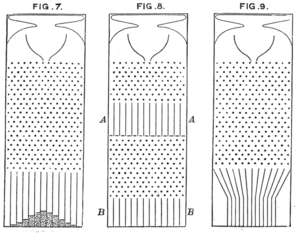
To show this idea, Galton invented the Galton board, also known as a "bean machine." This device uses falling beads to demonstrate how random events can create a bell-shaped curve (normal distribution).
Correlation and Regression
Galton independently discovered the concept of correlation in 1888. Correlation shows how two things change together. For example, he looked at how forearm length and height were related. He also invented the use of the regression line and the letter 'r' to represent the correlation coefficient, which is still used today.
Fingerprint Classification
The idea of using fingerprints to identify criminals was first introduced in India by Sir William James Herschel in the 1860s. Galton became interested in this field and helped create a scientific basis for studying fingerprints. This helped courts accept fingerprints as evidence.
In his books, Galton estimated the chance of two people having the same fingerprint. He also studied how fingerprints might be inherited and if there were racial differences. He developed a system to classify fingerprints into eight main categories, which is still used today. These categories include plain arch, tented arch, simple loop, and plain whorl.
Later Years
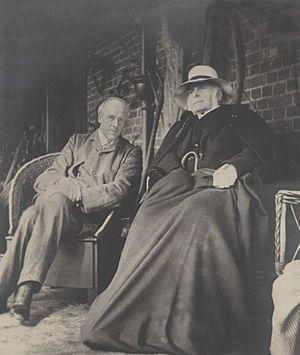
In his final years, Galton tried to write a novel called Kantsaywhere. It was about a perfect society based on his eugenics ideas, where people were bred to be fitter and smarter. However, the book was never fully published during his lifetime.
Sir Francis Galton passed away on January 17, 1911, and is buried in Claverdon, Warwickshire, England.
Awards and Recognition
Galton received many awards throughout his career.
- In 1853, he received the Founder's Medal from the Royal Geographical Society for his explorations in Africa.
- He became a Fellow of the Royal Society in 1860.
- He received the Gold Medal of the Royal Society in 1886.
- In 1910, he was awarded the prestigious Copley Medal by the Royal Society.
- He was knighted in 1909, becoming "Sir Francis Galton."
The flowering plant genus Galtonia was named after him.
Images for kids
See also
 In Spanish: Francis Galton para niños
In Spanish: Francis Galton para niños


